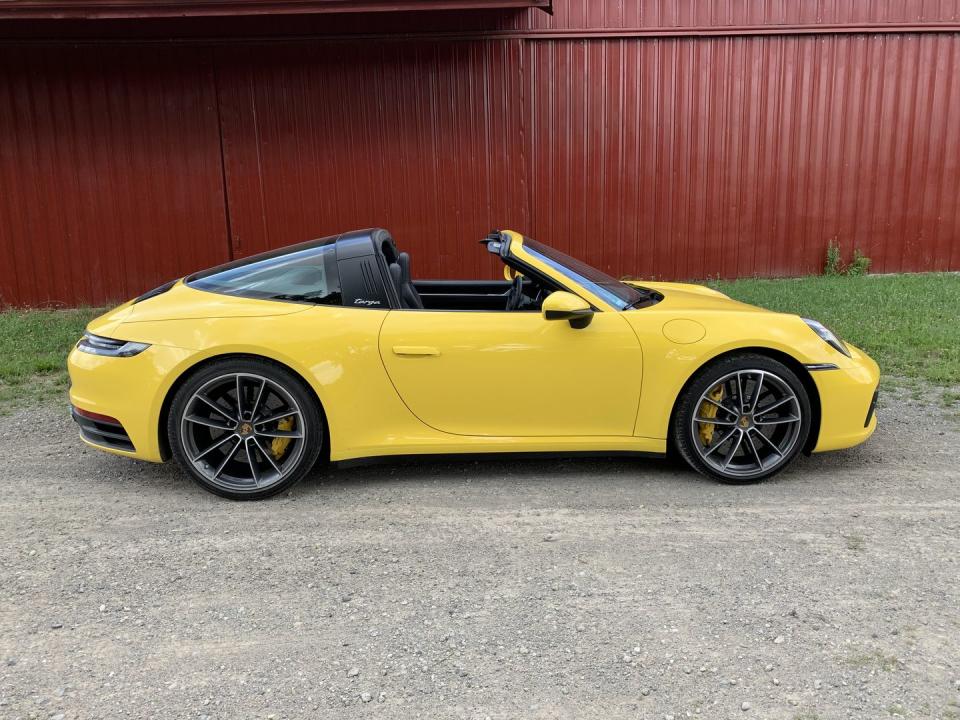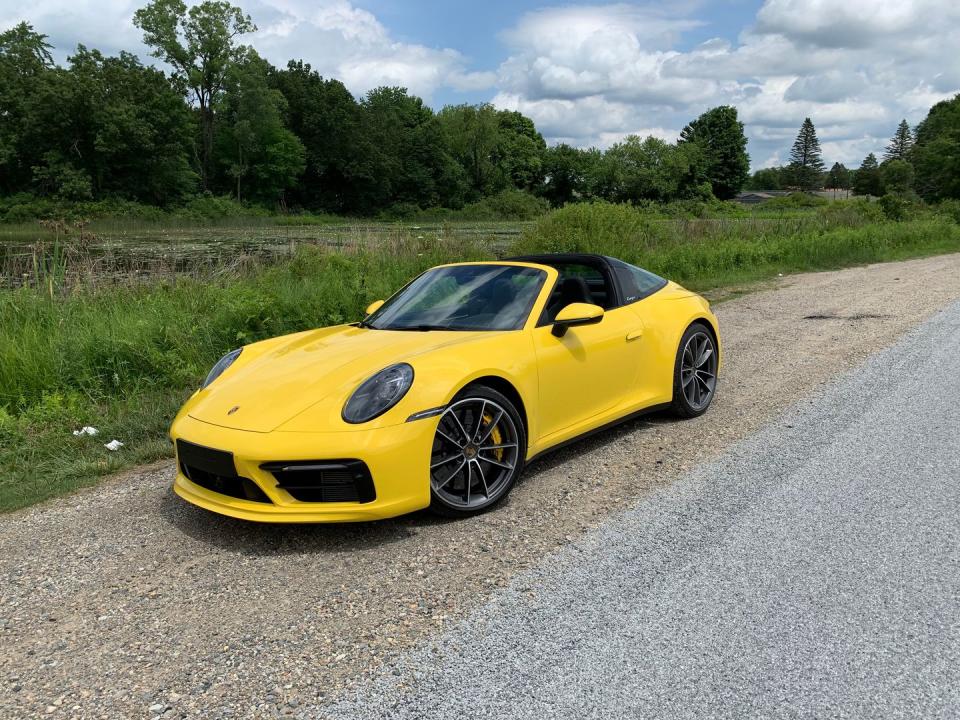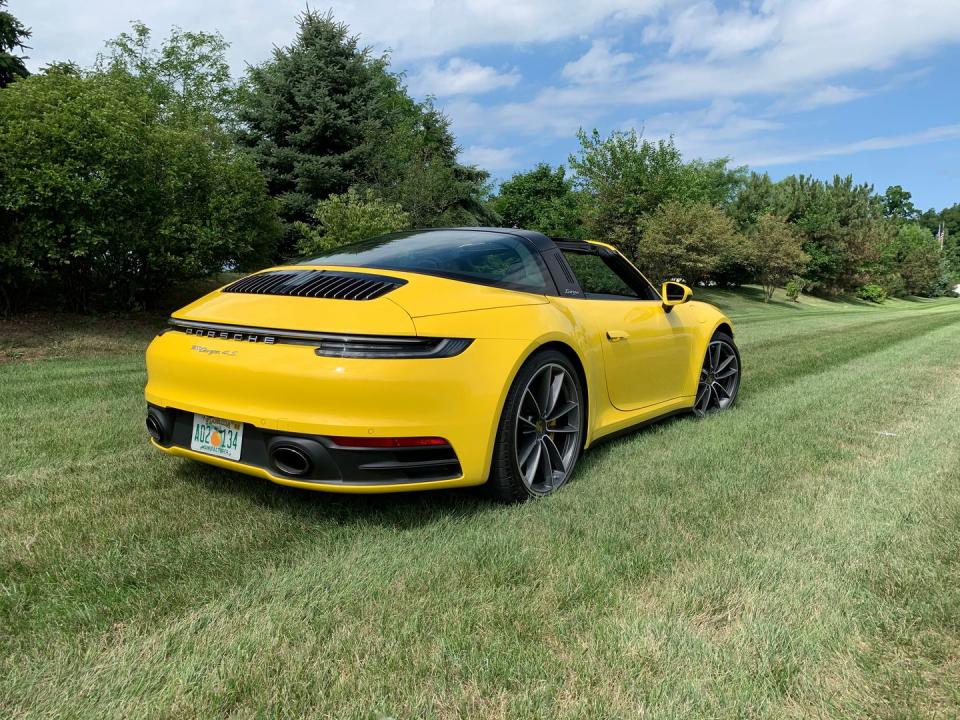2021 Porsche 911 Targa: Best of Both Worlds?

In theory, a Targa body style gives you more chassis stiffness and less weight than a convertible, but still lets the sunshine in. And it’s true, the 2021 Porsche 911 Targa is 44 pounds less than the 911 convertible, but it still weighs about 200 pounds(!) more than the hardtop, most of which is the automatic mechanical top. Why not go with a no-machinery, one-piece pop top? That’s not what well-heeled 911 fans want in their six-figure sports car, Porsche says.
Granted, it was nice taking a full day to cruise the back roads of Michigan on a perfect 80-degree day. And when I got home and didn’t have to fiddle with stretching fabric and top clips, I did see the advantages. And I suppose if one wanted the most rigid, track-facing 911, one would just get the coupe.
The 911 Targa (with the wraparound glass and targa bar) came back in 2014 in the 991 generation and was lauded for its good looks. And I agree, especially in what Twitter is calling “murder hornet yellow.” The only angle where it doesn’t look fantastic is that rear three-quarter. For some reason the bubble butt and the extra glass just makes it look, out of proportion, or something.

The 2021 Porsche 911 Targa only comes in 4 and 4S grades meaning all-wheel drive and super wide hips that take up half of the sideview mirrors. It looks great in those side pods but it did make me a little nervous on my spectacular new drive loop that was perfect, except for a few portions that were being repaired. That meant a ton of little rocks, all of them bouncing from the under the front tires to those wide hips. These testers had protective clear plastic film over the broad part of those haunches, preventing any damage. I suggest if you buy any wide Porsche, you add them to your list of extras.
Both Targas get Porsche’s 3.0-liter, twin-turbo boxer six and an eight-speed PDK (dual-clutch) transmission (a seven-speed manual is a no cost option). The Targa 4 puts down 379 hp and with the Sport Chrono Package will sprint to 60 in 4 seconds flat. That’s one-tenth faster than before. The 4S makes 443 hp, leading to a 3.4-second sprint over the same distance. The top speed of the 4 is 179 hp while the 4S goes up to 188.
An electronically controlled rear differential lock is standard, but with the Sport Chrono package, Porsche swaps that for a mechanical LSD. The Sport Chrono Pack comes with the steering wheel drive mode dial, more aggressive settings for the powertrain and suspension, dynamic engine mounts, the stopwatch on the dash and Porsche track app. That option box will cost you $2,790.
This vehicle also has PDCC, Porsche Dynamic Chassis Control, using electromechanical antiroll bars to keep the body flat through corners. That option is $3,170. Tack on the carbon ceramic brakes for about nine grand, the sport front fascia for $3,240, the rear axle steering ($2,090) and the LED matrix headlights ($4,010) and a few other options, and the base price rockets from $135K to $181K faster than the 19 seconds it takes to open the top. By the way, the well-heeled should know that the manual top on the Mazda Miata takes about one second to open.

Tires on the Targa 4 come staggered with 235/40 19s on the front and 295/35 20s on the rear. The 4S upgrades those to 245/35 20s in the front and 305/30 21s in the rear. Targa 4s get 13-inch, four-piston front rotors, the 4S gets 13.8-inch rotors with six-piston clampers. The carbon ceramic brakes measure 16.1 inches. I think every Porsche I’ve driven in recent months had near perfect brake feel: short stroke, hard to press, and just the right amount of sensitivity not to be jerky during the last few feet, or when letting off from a stop.
New in the 911 is Porsche InnoDrive, which is its version of traffic-jam assisted driving that will both keep your car in the lane and accelerate and brake up to 37 mph, along with Smartlift that can be programmed to lift the nose of the Targa at preset navigation points, like my driveway.
There are a few new leather options inside, including the historical “930,” inspired by the ‘70s and ‘80s generation, and you can get a few two-tone options as well. The red/chalk is probably the best with the right exterior colors, but gray/green and blue/beige must also look fantastic. Alternately, skip the full leather packages all together and get this fabric, houndstooth-looking setup.

I have almost a full day to wring out the new transformer top 911. I start at my secret string of new roundabouts before my preordained drive route. Right away the new Targa displays its skills. The steering takes a lot of effort, but the ratio is quick, leading to the feeling that you’re actually grabbing the nose of the vehicle and yanking it left and right. I never turn the wheel more than 90 degrees.
I like this spot because the speeds are reasonably high and when you clip those, gentle, 40-degree angle curbs you can feel whether the chassis is flexing. And, if so, by how much. You don’t want to go airborne (too rigid) or feel the car wobble or twist (not rigid enough). The Targa has about 10 percent more flex than the hard top, which on anywhere except a racetrack is probably preferable. Does one need 100 percent of what Porsche can do with a chassis on everyday surface streets? Probably not. Furthermore, the rear-axle steering keeps it preternaturally tight along the lane lines.
As I venture to the middle of the Mitten state, the roads get better with more beautiful, sweeping curves. Traffic also thins out and again I’m reminded of why Porsche is top tier in driver engagement. Even in this world of electronic power steering and "driving aids" that most makers use to separate the driver from the road.


 Yahoo Autos
Yahoo Autos 